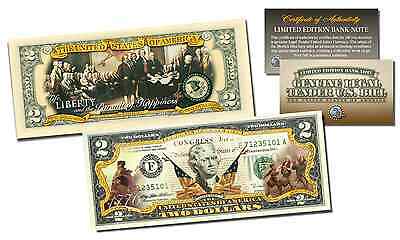-40%
T-39 PF-13 1862 0 Confederate Paper Money
$ 5.32
- Description
- Size Guide
Description
T-39 PF-13 0.00 1862 CSA Currency. Milkmaid to the left. Railway train with straight steam from the locomotive in the center. Printed on plain paper. J. T. Paterson & Co. Columbia SC. Serial number 29601. Plen Ah.Fine to Very Fine using traditional grading. Pin hole. Pin hole. Nice color for the grade and type. Probably a PMG or PCGS Very Fine 25 or 30 pin hole.
Genuine.
This was the first interest bearing 0 note to be issued in large quantities by the Confederacy. They paid a 7.3% annual interest rate; double that of the First Series notes of Montgomery and Richmond. Some were issued by agents by hand, and their signatures—and sometimes the place of issue—are written on the backs. Some T-39s also have interest paid stamps on the backs indicating that the interest was collected by the bearer. The notes have a popular “Train” vignette on the front, with easily visible “straight steam” (all white) coming out of the smokestack. To the left is a vignette of a milkmaid. Once thought to be an apple, the object in her left hand above her head is most likely the handle of the bucket on her head. These notes were payable six months after the ratification of a Treaty of Peace between the Confederate States and United States and were not fundable.
This type comes on moderate quality paper. As they were interest bearing, many were saved, and high quality examples are easily found. However, many were not cut well due to the higher volume of production as compared with many of the 1861 notes.
There are a number of different sizes of plate letters ranging from very small to very large and including small, medium, and large in addition to the extreme cases. Since these were hand placed they varied from position to position on the same plate. For simplicity, I will adhere to a simplified version of the Bradbeer/Criswell basic mappings to enable a majority of people to attribute these correctly and easily. I leave it to others to describe the minutiae of every variation, which may drive the number of T-39 varieties to hundreds. Furthermore, there are people interested in collecting these by date, and those listings may be found in the “Register of the Confederate Debt” by Thian.
This type is common in all grades except Choice Extremely Fine to Choice Uncirculated
.
A note about 3rd party grading. PCGS and PMG do a good job putting a floor on quality within a grade range and have become proficient in detecting repairs (though occasionally they miss something, or see something that is not there, as we all can).
Notes housed in Net or Apparent holders have a wide range of quality from very nice (in rare cases may be nearly choice) to dogs with major problems, so each needs to be evaluated on their own.
However, PMG and PCGS focus on technical grading due to circulation and damage and do not have a mechanism for evaluating condition or eye appeal - whether a note is average, better than average, choice or gem for the grade based on its color, trim and margins. The exception to this are slabbed notes of New or Uncirculated grades to some degree. This is important as Very Fine, Extremely Fine or AU notes can have a wide range of values depending on these factors not reflected in the slab grade. A fully framed Confederate or obsolete note is worth considerably to a lot more than one that is trimmed into the margin for the same grade. Likewise, color is important. These factors can affect the value of a note by 50%, 2-1 or even 3-1, e.g., an AU 58 (PPQ or not) T-20 1861 CSA note trimmed into the margin is worth between 0 and 0. The same grade, AU 58 (PPQ or not), with a full frame and good color/inking is worth something like 0 to 00 depending on eye appeal. I will continue to use the terms plus for above average, choice and gem to mean varying degrees of superiority of condition and eye appeal of a note within a grade as documented in my book which is based on what collectors seek out and pay premiums for.
In coins, we’ve seen the third party graders add things like full bell lines, full head, full bands which reflected the market. I’d expect either the grading services or another party to do the same for paper money. If you are just buying the number on the holder for the best price, you may well be buying low end notes for the grade!
Pierre Fricke. Immediate Past President of the Society of Paper Money Collectors; Professional Numismatists Guild (PNG); Professional Currency Dealers Association (PCDA); ANA, EAC, etc...
BuyVintageMoney.
Author of the standard guide book to Confederate money - Collecting Confederate Money Field Edition 2014.
Free shipping and insurance.
eBay has announced that it will start to collect sales tax on behalf of sellers for items shipped to customers in Alabama (Jul 1), Connecticut (Apr 1), Iowa (Feb 1), Minnesota (Jan 1), New Jersey (May 1), Oklahoma (Jul 1), Pennsylvania (Jul 1), and Washington (Jan 1). Additional states are being added like Idaho and more than 20 others. This is the new internet tax out of the US Supreme Court Wayfair decision. Buyers are responsible for paying this sales tax.
See eBay information for list of states eBay charges this tax payable by buyers to eBay as part of eBay invoices -- https://www.ebay.com/help/selling/fees-credits-invoices/taxes-import-charges?id=4121#section4










